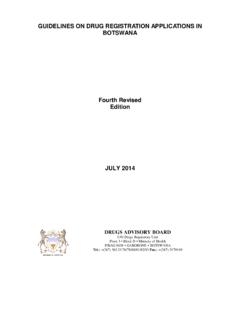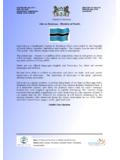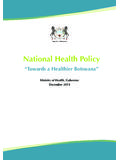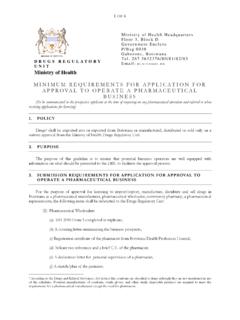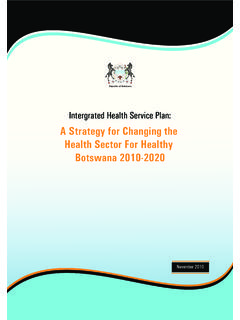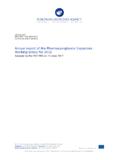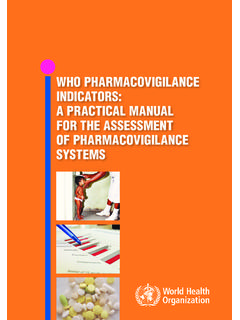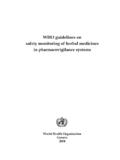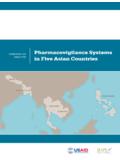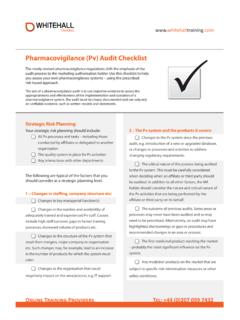Transcription of Pharmacovigilance guidelines Nov 2009 - Botswana
1 1. DRUG REGULATORY UNIT. MINISTRY OF HEALTH ENCLAVE. P/BAG 0038, GABORONE, Botswana . PH: +267-3632383. FAX: + 267-317-0169. Pharmacovigilance . guidelines . DRUGS REGULATORY UNIT. NOVEMBER 2009. SECOND EDITION. 2. 1 INTRODUCTION: ..3. DEFINITIONS: ..4. 2 REPORTING OF ADVERSE DRUG REACTION ..5. REPORTING WHO SHOULD REPORT? ..5. WHAT TO REPORT? ..6. VOLUNTARY REPORTING ..6. 3 COMMUNICATIONS: ..6. 4 DUTIES AND 5 FORM 8. 3. 1 INTRODUCTION: Pharmacovigilance is the science and activities relating to the detection, assessment, understanding and prevention of adverse effects or any other possible drug-related problems. Pharmacovigilance is closely linked to drug regulation. The major aims of Pharmacovigilance are: Early detection of unknown adverse reactions and interactions.
2 Detection of increases in frequency of known adverse reactions. Identification of risk factors and possible mechanisms Estimation of quantitative aspects of benefit/risk analysis and dissemination of information needed to improve medicine prescribing and regulation. The specific aims of Pharmacovigilance are to: Improve patient care and safety in relation to the use of medicines and all medical and paramedical interventions, Improve public health and safety in relation to the use of medicines, Contribute to the assessment of benefit, harm, effectiveness and risk of medicines, encouraging their safe, rational and more effective (including cost-effective) use, and Promote understanding, education and clinical training in Pharmacovigilance and its effective communication to the public.
3 It is important to achieve the development of a positive attitude towards Pharmacovigilance among healthcare professionals so that adverse reaction reporting becomes an accepted and understood routine. The following may stimulate reporting: Easy access to reporting forms and other means of reporting Acknowledging the receipt of adverse drug reaction reports by personal letter or phone call Providing feed-back to reporters in the form of articles in journals, adverse drug reactions bulletins or newsletters Participation of the centres staff in pre- and postgraduate education and scientific meetings Collaboration with local drug or Pharmacovigilance committees Collaboration with professional associations Integration of Pharmacovigilance in the (further) development of clinical pharmacy and clinical pharmacology in a country.
4 Under reporting is a common phenomenon in all countries. Under-reporting may delay signal detection and cause underestimation of the size of the problem. However, in signal detection not only the quantity but also the relevance of case reports and quality of data are important. 4. Sometimes healthcare professionals fear that the acknowledgement of adverse reactions may reflect negatively on their competence or put them at risk of litigation. Some are reluctant to report adverse reactions because of doubts regarding the causal role of the drug. Under-reporting is both a technical and a psychological issue. Clarity of criteria for reporting, simple procedures and good motivational practice are all influential in addressing the problem. Definitions: An adverse drug reaction (ADR) is a response to medicine which is noxious (an unexpected therapeutic response) and unintended, and which occurs at doses normally used in man'.
5 An unexpected adverse reaction is an adverse reaction, the nature or severity of which is not consistent with domestic labelling or market authorization, or expected from characteristics of the drug'. A drug or medicine is a pharmaceutical product, used in or on the human body for the prevention, diagnosis or treatment of disease, or for the modification of physiological function'. A side effect is any unintended effect of a pharmaceutical product occurring at doses normally used by a patient which is related to the pharmacological properties of the drug'. An adverse event or experience is defined as any untoward medical occurrence that may present during treatment with a medicine but which does not necessarily have a causal relationship with this treatment'. A signal refers to reported information on a possible causal relationship between an adverse event and a drug, the relationship being unknown or incompletely documented previously'.
6 A serious adverse event is any event that: Is fatal Is life-threatening Is permanently/significantly disabling Requires or prolongs hospitalization Causes a congenital anomaly Requires intervention to prevent permanent impairment or damage. 5. 2 REPORTING OF ADVERSE DRUG REACTION. Spontaneous reporting of suspected adverse drug reactions is the major source of information in Pharmacovigilance . This information can be obtained from a regional or country-wide system for reporting. Reporting form The reporting form contains information on the following elements: 1. The patient: age, sex, ethnic origin and brief medical history 2. Adverse event: description (nature, location, severity, characteristics), results of investigations and tests, start date, course and outcome.
7 3. Suspected drug(s): name (brand or ingredient name and manufacture), daily dose, route, start/stop dates, indication for use (with particular drugs, vaccines, a batch number is important). 4. All other drugs used (including self-medication): names, doses, route, start/stop dates. 5. Risk factors ( impaired renal function, previous exposure to suspected drug, previous allergies, social drug use). 6. Name and address of reporter (to be considered confidential and to be used only for data verification, completion and case follow-up). The reporting forms will be distributed throughout the target area to healthcare professionals at regular intervals. Telephone, fax and electronic mail or internet can be used for reporting ADR's. Who should report? Professionals working in healthcare are the preferred source of information in Pharmacovigilance .
8 These include family practitioners, medical specialists, nurses and pharmacists and pharmacy technicians. Other health workers and family members can play an important role in the stimulation of reporting and in the provision of additional information ( on co-medication and previous drug use). Pharmaceutical manufacturers, applicants and research organizations have to ensure that suspected adverse reactions to their products are reported to the competent authority. If adverse reactions are reported directly by patients to the national or local centre, the 6. centre will communicate with their physicians for additional information and data verification. What to report? For new drugs- report all suspected reactions, including minor ones. For established or well-known drugs- report all serious or unexpected (unusual).
9 Suspected ADRs Report if an increased frequency of a given reaction is observed. Report all suspected ADRs associated with drug-drug, drug-food or drug-food supplements (including herbal or complementary products) interactions. Report ADRS in special fields of interest such as drug abuse and drug use in pregnancy and during lactation. Report when suspected ADRs are associated with drug withdrawals. Report ADRs occurring from overdose or medication error. Report when there is a lack of efficacy or when suspected pharmaceutical defects are observed. Voluntary reporting The reporting of adverse drug reactions is voluntary. It is mandatory for pharmaceutical companies to report suspected adverse drug reactions to the health authorities. 3 COMMUNICATIONS: A bulletin distributed to all healthcare professionals for the dissemination of information.
10 In urgent cases of sufficient importance Dear Doctor letters may alert the profession. 4 DUTIES AND RESPONSIBILITIES. Doctors, Nurses and other health professionals Report any suspected adverse drug reactions, drug interactions and unusual effects immediately. Fill the reporting form and hand over it to the Pharmacy Unit of the health institution or mail directly to DRU. Pharmacy Unit Mail the ADR report to DRU. Retain the necessary documentation Make sure availability of reporting form. 7. Pharmacy/Drugs and Therapeutic Committee Revise the drug list of health institution Promote rational use of drugs Distribute ADR information to the health professionals Ensure all the ADR report be kept confidential. Drug Regulatory Unit (DRU). Promote reporting Collect report Give feedback Review the reported ADRs.


